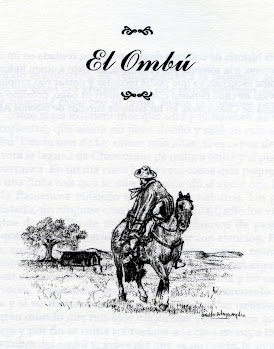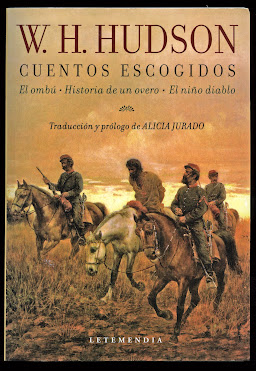 |
| Ilustration for W.H.Hudson's story El Ombú |
When I wrote this blog yesterday about objectivity according to Santiago Genovés, Olaf Stapledon and Kazi Ishiguro I was compelled to consult one of the books mentioned which is Borges’s Prólogos con un prólogo de prólogos. Borges had a fondness for writing prologues and I wanted to check what he had written for Olaf Stapledon’s Starmaker.
After reading it I read a few more. I then went, inevitably to the one title El Gaucho. It was there where at the end he cited Argentine-born writer (he only ever wrote in English) W.H. Hudson (commonly calle Guillermo Enrique Hudson in Argentine where Washington is Jorge Washington.
This is what he wrote in Spanish (my translation follows):
“…no querría olvidar los [libros] de Hudson que, nacido y criado en la pampa, buscó el destierro para sentir mejor lo que perdió.”
“.., I would not want to forget to cite Hudson[books] who having been born and raised in la pampa, he looked for exile so he could feel better what he had lost.”
With my recent obsession of listening to Argentine folklore zambas (with a zed) I feel in a way to be like Hudson.
As I wrote here, I had never listened to this music until I went to Buenos Aires this past December of 2021.
How can one feel a nostalgia for something new?
Jorge Luís Borges, in his wisdom, nailed it for me. I have also been persuaded by his prologue on the gaucho to read Estanislao del Campo’s (February 7, 1834 – November 6, 1880), 1866, Fausto, Impresiones del gaucho Anastasio el Pollo en la representación de la Ópera (1866) which is about a gaucho going to see Gounod’s opera in a Buenos Aires theatre and being confused on what was real and what was not.
It would seem that at my age of 79 I will have to do a lot of catching up with Guillermo Enrique Hudson to feel better what I have lost in not reading much Argentine literature except for Borges, Cortázar, Jose Hernández’s Martín Fierro and the poetry of Alfonsina Storni and Alejandra Pizarnik.
My favourite W.H. Hudson story is El Ombú. This tree (not really as it has no real bark or wood) is a massive aparition if one visits the Argentine Pampa.
Phytolacca dioica, commonly known as ombú, is a massive evergreen tree native to the Pampa of South America. As its specific epithet suggests, it is dioecious, with male and female flowers on separate plants.It has an umbrella-like canopy that spreads to a diameter of 12 to 15 meters (40 to 50 feet) and can attain a height of 12 to 18 meters (40 to 60 feet). Because it is derived from herbaceous ancestors, its trunk consists of anomalous secondary thickening rather than true wood. As a result, the ombú grows fast but its wood is soft and spongy enough to be cut with a knife. These properties have led it to be used in the art of bonsai, as it is easily manipulated to create the desired effect. Since the sap is poisonous, the ombú is not grazed by cattle and is immune to locusts and other pests. For similar reasons, the leaves are sometimes used as a laxative or purgative. It is a symbol of Uruguay and Argentina, and of gaucho culture, as its canopy is quite distinguishable from afar and provides comfort and shelter from sun and rain.








